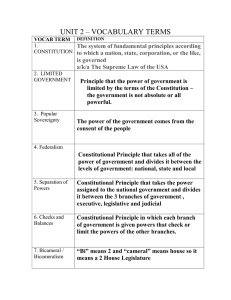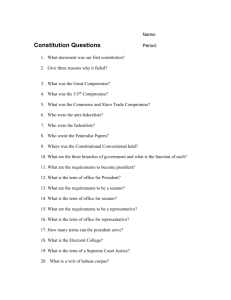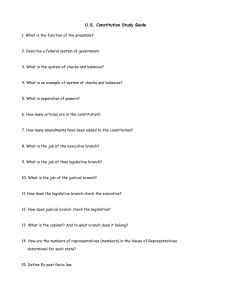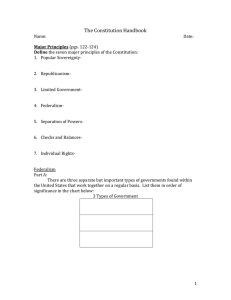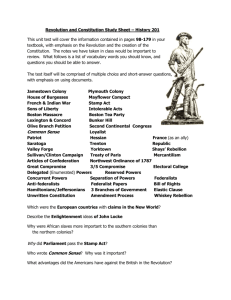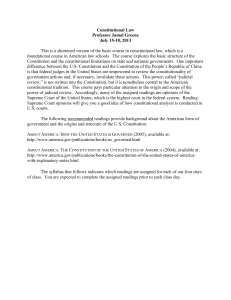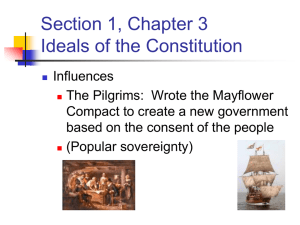Constitution Notes
advertisement
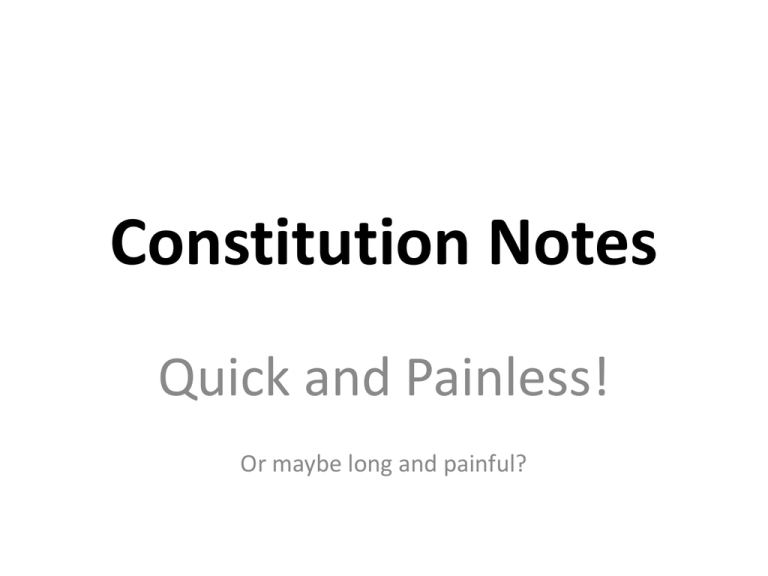
Constitution Notes Quick and Painless! Or maybe long and painful? The US Constitution was written by infallible people, from all walks of life, who knew everything about the future of the country and the world, and who possessed perfect answers to all of life’s problems. The world never changes, our country is exactly the same today as it was when it was founded, people never get smarter, no one knows any more today than the first humans who existed nearly 200,000 years ago. True or False? Why am I asking you this seemingly stupid question? Supreme law of the land! Adopted on September 17, 1787, by the Constitutional Congress in Philly. The main author was James Madison After ratification in eleven states (only needed nine) it went into effect on March 4, 1789. The Preamble of the Constitution • “We the people of the United States, in order to form a more perfect union, establish justice, insure domestic tranquility, provide for the common defense, promote the general welfare, and secure the blessings of liberty to ourselves and our posterity, do ordain and establish this Constitution for the United States of America.” • The purpose of the Preamble was simply to explain why they were creating a national government. Articles I, II, and III… Separation of Powers • Legislative – Congress: House of Reps. & Senate • Executive – President and the President’s peoples • Judicial – The Supreme Court and so on Checks and balances! Separation of Powers • Legislative – makes laws – Senate: 2 from each state • 6-year term – House of Representatives: based on population • 2-year term • (5 slaves count as 3 people: Compromise!) – Bicameral legislature • (compromise due to conflict over representation) – Implied v. Direct powers • Direct = Declare war, Ability to tax, etc. • Implied = Set a minimum wage, etc. The Necessary and Proper Clause • Also known as “The Elastic Clause” – Congress (Legislative branch) shall have power to make all laws which shall be necessary and proper Separation of Powers • Executive – enforces laws – Chief executive: President • • • • 4-year term Elected by the Electoral College Must be a “natural born citizen” (born in the US) Commander-in-chief – President’s cabinet – Law enforcement: FBI Separation of Powers • Judicial – interprets laws and provides trials – Supreme Court: states whether laws are constitutional • 9 Supreme Court Justices • Life-long term • Appointed by President – Appellate court: hears appeals from district courts – District court: tries people who break federal laws Articles I, II, and III, STOP! Federalism • Authority is divided between a central governing authority and constituent political units (such as states or provinces). • Remember the circles? Federalists v. Anti-Federalists • Federalists wanted a strong national government • Anti-Federalists were afraid of giving the national government too much power Judicial Review • Legislative and executive actions are subject to review (and possible invalidation) by the judiciary – In other words, the courts can decide whether or not the government’s actions are constitutional – Established in Marbury v. Madison Limited Government • The national government is only allowed the powers given to it by the Constitution; not supreme power • Intervention in personal liberties and the economy is supposed to be minimal Popular Sovereignty • “We the people…” ! • Government is legitimate only so far as it is supported by the consent of “the people” • “The people” are the source of all political power – Of course, at the time, “the people” excluded most of the population, such as women, African Americans, Native Americans, those lacking sufficient property, and children. But we have come a long way since then!!! Article V: Amendments! • Additions and alterations can be made to the Constitution Upcoming: The Bill of Rights • After much debate, the compromise that finally resulted in the Anti-Federalists going along with the ratification of the Constitution was the promise to add a Bill of Rights.
